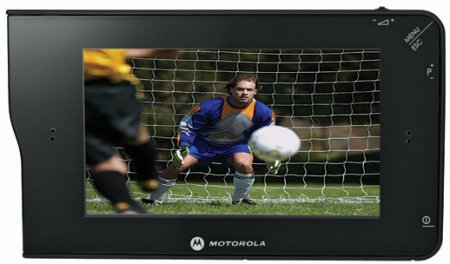Mot demo’s Linux-based DVB-H handheld
Jan 7, 2008 — by Eric Brown — from the LinuxDevices Archive — 4 views Motorola has announced a personal media player (PMP) and related broadcast transmission equipment based on the emerging wireless TV broadcast standard, DVB-H (digital video broadcast, handhelds). The Linux-based Mobile TV DH01 handheld will enable the viewing of live, on-demand, and recorded programs, says Motorola.
Motorola has announced a personal media player (PMP) and related broadcast transmission equipment based on the emerging wireless TV broadcast standard, DVB-H (digital video broadcast, handhelds). The Linux-based Mobile TV DH01 handheld will enable the viewing of live, on-demand, and recorded programs, says Motorola.
digg this story |
Along with rivals such as Nokia, Samsung, and LG, Motorola already sells phones that offer live TV playback. However, because they are not optimized with a technology such as DVB-H, the quality is lower and the phones quickly use up battery life as they struggle to process video. Motorola joins Nokia as a major backer of the IP-based DVB-H, which is optimized for 3G-enabled handheld displays, and which broadcasts data in bursts to accommodate battery-dependent devices (more on DVB-H below).

Motorola's MobileTV DH01
(Click to enlarge)
Motorola's Mobile TV DH01 is smaller than a paperback novel, says Motorola, and will enable live or recorded DVB-H playback at 25fps (frames per second), indoors or outdoors. It boasts a 4.3-inch screen with 16 million colors, an SD slot, USB, DVR capability, and support for numerous video and audio codecs. Based on “non-proprietary” Linux, the device is said to support open standard interfaces across devices, networks, and application service platforms.
Details were sketchy, but Motorola lists the following features on the DH01, which is being demonstrated at this week's CES show:
- Display — 4.3-inch Wide Quarter Video Graphics Array Screen, supporting up to 16 million colors
- Video frame rate -- 25fps
- Flash — SD/MMC card slot
- DVR — via supported Secure Digital/MultiMediaCard card; 90 minutes of TV video storage on 256MB card
- I/O — Mini A/B USB connector; USIM/UICC card reader; earphone and power jacks
- Video formats — H.264 AVC QVGA, MPEG-4 SP level 3 QVGA
- Audio formats — AAC, MP3
- Image formats — JPEG, GIF, PNG
- Battery — rechargeable battery with up to four hours per charge
- Other features — Five-minute memory buffer for live-TV pause; automatic channel scan; channel listings
Motorola will also introduce “standards-based” DVB-H transmission network equipment and video head-end center equipment, says the company. In addition, it will develop an interactive application services delivery platform for wireless network infrastructure.
About DVB-H
The DVB-H standard is one of three major competing standards for wireless TV broadcast to portable devices. The biggest rival is Digital Multimedia Broadcasting (DMB), which is based on the Digital Audio Broadcasting (DAB) standard. DAB is being used extensively in South Korea and is being tested in China and several European countries. The third is QualComm's MediaFlo, technology which is being tested by Verizon Wireless in the U.S.
DVB-H is an offshoot of the terrestrial DVB-T and the satellite DVB-S standards. Based on DVB specifications for IP datacasting called DVB-IPDC, it broadcasts content in bursts in a way that is optimized for wireless handheld devices. The technology uses time-slicing techniques so that handheld receivers can briefly power down in between transmission bursts in order to conserve battery life. A similar standard called DVB-SH is designed for hybrid satellite/terrestrial receivers, and a HD version is in the works called DVB-H2.
The U.S. campaign for DVB-H suffered a major setback in 2007 when the two major ventures sold their spectrum. In July, Crown Castle International said it was selling the L-band, 1670-1675MHz spectrum that it was going to use for its DVB-H-based Modeo network to a venture between Telcom Ventures and Columbia Capital. Then, in October AT&T announced it was purchasing 700MHz spectrum from Hiwire, which the company had been planning to use to roll out a nationwide DVB-H network. Yet, there has been speculation that AT&T may be interested in DVB-H, after all.
Meanwhile, DVB-H appears to be alive and well in dozens of other countries, especially in Europe, with commercial services available in Italy, Finland and other countries. Yet many DVB-H projects are stuck in pilot test stage due to a shortage of wireless airwave licenses.
Stated Navin Mehta, VP of Mobile TV for Motorola, “Mobile TV is expected to grow significantly in 2008 and beyond, and Motorola is in a unique position to mobilize the TV experience to deliver broadcast and personalized content wherever and whenever consumers want.”
Availability
Motorola did not provide details on the pricing or availability of the Mobile TV DH01 product line.
This article was originally published on LinuxDevices.com and has been donated to the open source community by QuinStreet Inc. Please visit LinuxToday.com for up-to-date news and articles about Linux and open source.